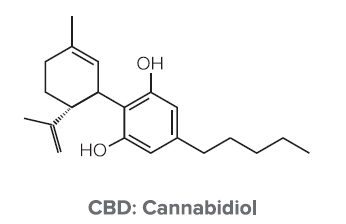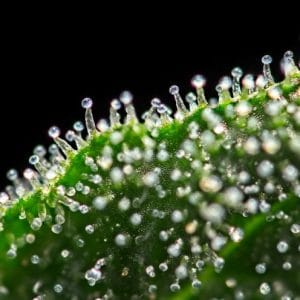What is CBD or cannabidiol, the popular cannabis ingredient?
Cannabidiol, abbreviated as CBD, is a cannabinoid and is only found in the cannabis plant. CBD is getting a lot of attention, and everyone knows someone who uses it. But what is CBD, and how does it compare to the other cannabinoid THC? And what is it used for?
There are currently more than 100 different identified cannabinoids, of which THC is the best known. CBD and THC are very similar in their chemical structure but have very different effects.
Can you get high from CBD?
CBD has medicinal properties but cannot make the user feel ‘high’. THC can. Some studies suggest that CBD may be effective in treating symptoms of rheumatoid arthritis, diabetes, PTSD, anxiety disorder, and antibiotic-resistant infections, among others.
CBD and epilepsy
More recently, CBD has been used in children with treatment-resistant epilepsy, and a subsidy has been made available by the Dutch government for further research. This study will not only look at CBD, but cannabis products in general, including THC.

THC is more likely to be used to reduce nausea, vomiting, pain and muscle spasms and improve sleep and appetite and the scientific evidence for its effectiveness in these conditions is more sound than the one available for CBD.
Ideal THC:CBD ratio
It has been shown that CBD can influence the effects of THC. However, it is still difficult to say which THC:CBD ratio is the most ideal for a specific medical condition. As an example, a study into the pain experienced by fibromyalgia patients showed that the combination of CBD and THC had a better effect on pain reduction than a product with THC alone. Conversly, CBD alone had no effect on pain. In a follow-up study, the researchers are now looking if a THC:CBD balanced ratio cannabis is better than opiates in reducing fibromyalgia pain.
However, the ultimate medicinal effect of cannabis does not depend solely on CBD or THC.
CBD and driving
When using CBD and driving it is important to avoid combining CBD with THC. A study of the effects of THC on driving ability showed that cannabis containing both THC and CBD had a worse effect on driving performance than cannabis with only THC. Further, when participants received both THC and CBD, they had slightly higher levels of THC in their blood compared with when they had just received THC. CBD alone and driving, on the other hand, do go together. No evidence has been found that CBD negatively affects driving behaviour on its own.
Terpenes refine the therapeutic effect
Terpenes are the substances that give cannabis its characteristic smell and taste. So far, over 120 different terpenes have been found in cannabis, with unusual names such as myrcene, alpha-pinene and beta-caryophyllene.
Unlike cannabinoids, terpenes can be found everywhere in nature. For example, they are present in lavender, roses and pine trees. Some studies suggest that terpenes may counteract certain undesirable effects of THC, such as feelings of restlessness or loss of short-term memory, although thorough research on this topic is still lacking.
Certain terpenes may also have medicinal properties of their own: some are antibiotics, while others have analgesic or anti-inflammatory effects. Terpenes are therefore often used in aromatherapy.
Because there are many different terpenes, there are also many different combinations in which they can occur in a cannabis plant. As with cannabinoids, each specific mix of terpenes can lead to a unique medicinal effect. The terpenes are suspected to work with cannabinoids to modify or amplify their effects. This is known as the ‘entourage effect’.
Trichomes
CBD, like other ingredients, is produced by tiny glandular hairs that are present all over the cannabis plant. Also known as trichomes, these hairs produce a sticky resin that accumulates as tiny droplets at the end of each glandular hair. Trichomes are so small that you can only see them with a magnifying glass.

Trichomes are found on both male and female plants, but they are particularly concentrated in the tips of the female flower.
Acidic and neutral cannabinoids
THC and CBD are not present in the cannabis plant in ready-to-use form but must first be heated to a temperature of at least 180°C.
The plant only contains ‘acidic’ cannabinoids. THC is, therefore, primarily THC acid (THCA), and CBD from the plant is CBD acid (CBDA, also known as cannabidiolic acid). When these substances are sufficiently heated, the cannabinoid acids are converted into a neutral form known as THC and CBD. This chemical process is called decarboxylation.
Decarboxylation also occurs spontaneously in cannabis as a result of exposure to light and room temperature, although at a slower pace. However, cannabis can be kept for a very long time in the freezer.
CBD acid
Until recently, scientists thought that the acidic cannabinoids had no medicinal properties. However, these substances can indeed be interesting as medicines. For example, it appears that CBDA bactericidal properties and seems promising as an anti-inflammatory substance. Additionally, THC acid seems to have a strong effect on the human immune system.
CBD products from Bedrocan
Bedrocan has two different CBD products that are suitable for medical use: Bedrolina® and Bedrolite®. Check the product page for more information.
The actions of CBD
The human brain and other organs contain naturally occurring cannabinoid (CB) receptors and the chemicals that bind to them. This is called the human endocannabinoid system. CBD, by comparison to THC, has less affinity for the CB1 and CB2 receptors and works to partly block receptor activity (as a partial antagonist). CBD displays high potency as an antagonist of CB1 and CB2 receptor agonists in CB1- and CB2-expressing cells or tissues. Furthermore, CBD inhibits the uptake and hydrolysis of the endocannabinoid anandamide (AEA), thus increasing its concentration in the tissues where it is produced. CBD has been identified as a serotonin receptor (5-HT1A) agonist, which may be the basis of its purported anxiolytic and antipsychotic actions. [1-4]
References
- Davies, and S. Bhattacharyya, Cannabidiol as a potential treatment for psychosis. Ther Adv Psychopharmacol, 2019. 9: p. 1–16.
- Crippa, J., et al., Translational investigation of the therapeutic potential of cannabidiol (CBD): toward a new age. . Front Immunol, 2018. 9: p. 1-16.
- Campos, A. and F. Guimarães, Involvement of 5HT1A receptors in the anxiolytic-like effects of cannabidiol injected into the dorsolateral periaqueductal gray of rats. Psychopharmacology (Berl), 2008. 199: p. 223-230.
- Zanelati, T., et al., Antidepressant-like effects of cannabidiol in mice: possible involvement of 5-HT1A receptors. Br J Pharmacol, 2010. 159(1): p. 122-8.
Subscribe to our newsletter
Stay informed with our latest updates by subscribing to our newsletter for exclusive news and compelling content. Rest assured, we prioritize the integrity of your inbox, delivering quality over quantity, with newsletters dispatched judiciously.






